Traces of War

With the reinforced and well-supplied German forces closing in, the Allies waited to be evacuated from the small fishing village of Hora Sfakia on the south coast of Crete. On the nights of 28-30 May 1940, British and Australian navy ships from Alexandria picked up 11,000 Allied troops and returned with them to Egypt. When the Australian soldiers defending the ridge above Hora Sfaklia were outflanked by the Germans, the evacuation attempt was abandoned.1 With the remaining troops surrounded, the order was given to surrender; the Battle of Crete was over. Lieutenant James Carstairs wrote in his diary ‘We were given two alternatives (by Colonel T. Walker, senior officer present): surrender with honour, or break up into parties of three, four, or five, and have a shot at hiding in the hills, making an escape later. Almost the whole battalion (2/7 Australian Infantry Battalion) decided to have a go.2
The white-painted buildings of Hora Sfakia cling to the cliffs of the south coast of Crete, huddled at the base of steep scrubby mountains. I wound my way down to the village on a Saturday morning, and the small waterfront cafes were doing a lazy trade as locals slouched in the winter sun. Between the town and the harbour a memorial tells the story of the evacuation, a drama hard to imagine playing out in such a beautiful, peaceful place.
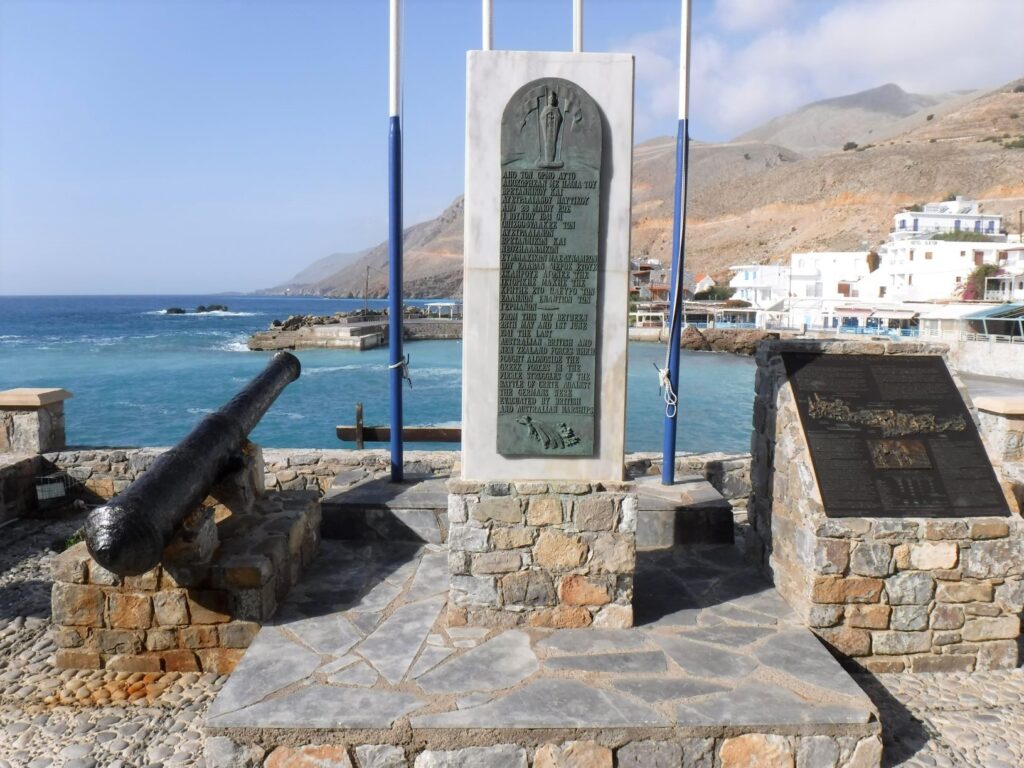
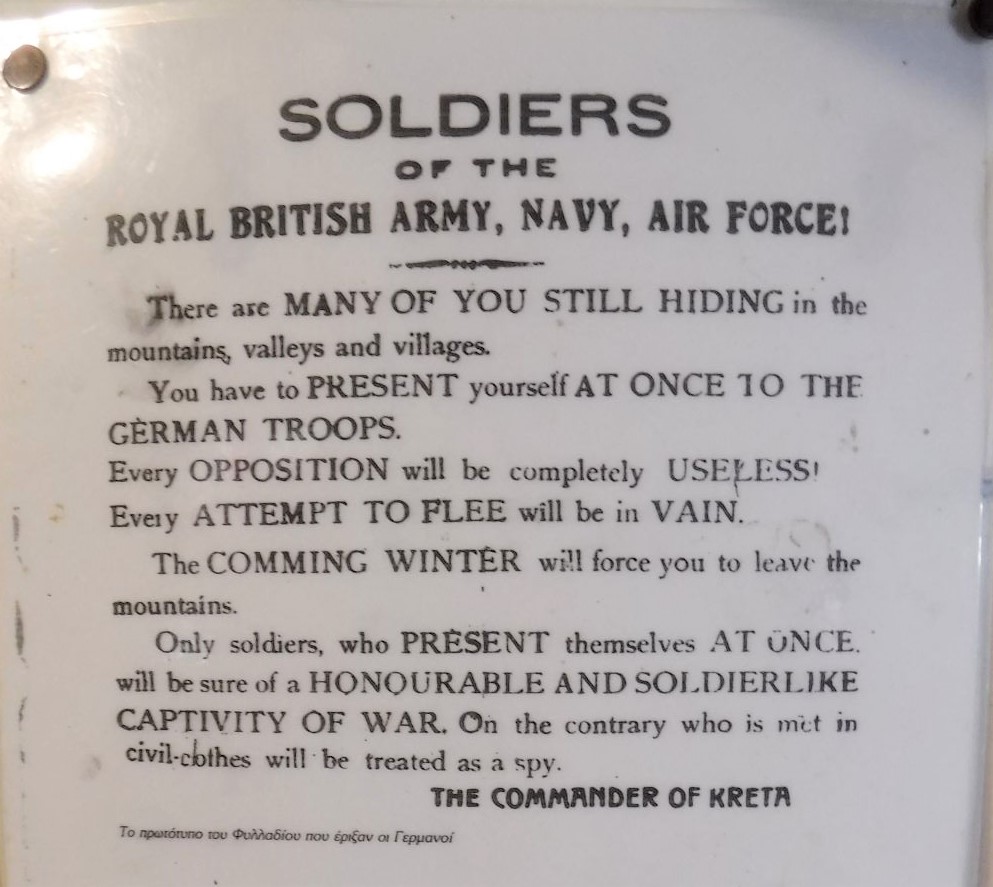
With the island under German and Italian control the Battle of Crete may have ended, however the Cretan resistance movement against the occupation was just beginning.
Copy of German directive to Allied soldiers on the run in Crete, Askifou War Museum
In addition to armed groups of resistance fighters carrying out sabotage and harassment operations, Cretan people provided Allied troops (who had missed the evacuation and chosen not to surrender, or who had escaped for Prisoner of War camps) shelter, food, and assistance to escape the island. For these actions, and for attacks by local civilians on the Germans during the invasion, the Cretan population paid a very high price. Captain W.S. Moss, a British Special Operations Executive agent sent to Crete during the occupation, wrote: ‘The Germans in Crete used to conduct their reprisals on the basis on 10 Cretans for every German killed, and this often resulted in the extermination of the population of an entire village or even district…3

A second memorial stands below the ruins of Hora Sfakia’s Venetian fort. Twenty-six people from the village were executed in September 1941 for providing assistance to Allied troops hiding in the district. Beneath the monument which bears their names are the bones of some of the victims of the massacre. A plaque placed by the New Zealand Crete Veterans stands nearby.
Monument to the Hora Sfakia massacre victims
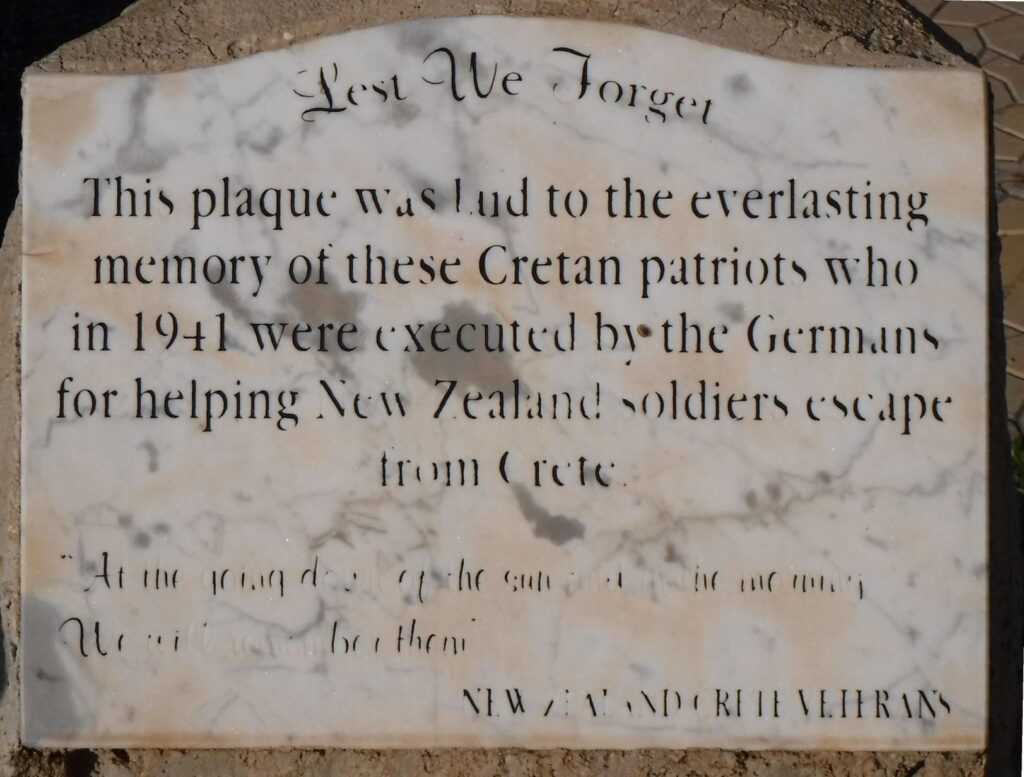
Memorial plaques are common in Crete’s ‘Martyrs’ Villages’, so-called for the reprisal killings committed against the townspeople. Some commemorate individuals, such as the memorial to Nicolaos Ieronimakis outside the small village of Kakopetros in western Crete.


In memory of Nicolaos Ieronimakis
Others remember the razing of entire villages. The destruction of Kandanos Village is one of the more infamous war crimes committed during the occupation.
General Kurt Student, the Commander-in-Chief of German forces, issued the following order shortly after the Battle of Crete: ‘It is certain that the civilian population including women and boys have taken part in the fighting, committed sabotage, mutilated and killed wounded soldiers. It is therefore high time…to undertake reprisals and punitive expeditions which must be carried through with exemplary terror. The harshest measures must indeed be taken…The following reprisals will be taken: shooting, fines, total destruction of villages by burning, extermination of the male population of the territory in question…there is no need for military tribunals to judge beasts and assassins’.4
This order was carried out in all its brutality in Kandanos on June 3rd, 1941, where the entire population of 180 people were murdered and the village razed to the ground.
I arrived in Kandanos in late afternoon misty rain, and after buying a few necessities from a little minimart, I wandered across the street to the town’s memorial square. Flags, honour rolls and a sculpture implore visitors not to forget the war crimes committed there. In a macabre postscript to the massacre in 1941, the Germans installed ‘gravestones’ at the village site to mark the atrocity. These monuments to brutality are kept in a Kandanos’ village museum, and replicas have been installed at the memorial site.
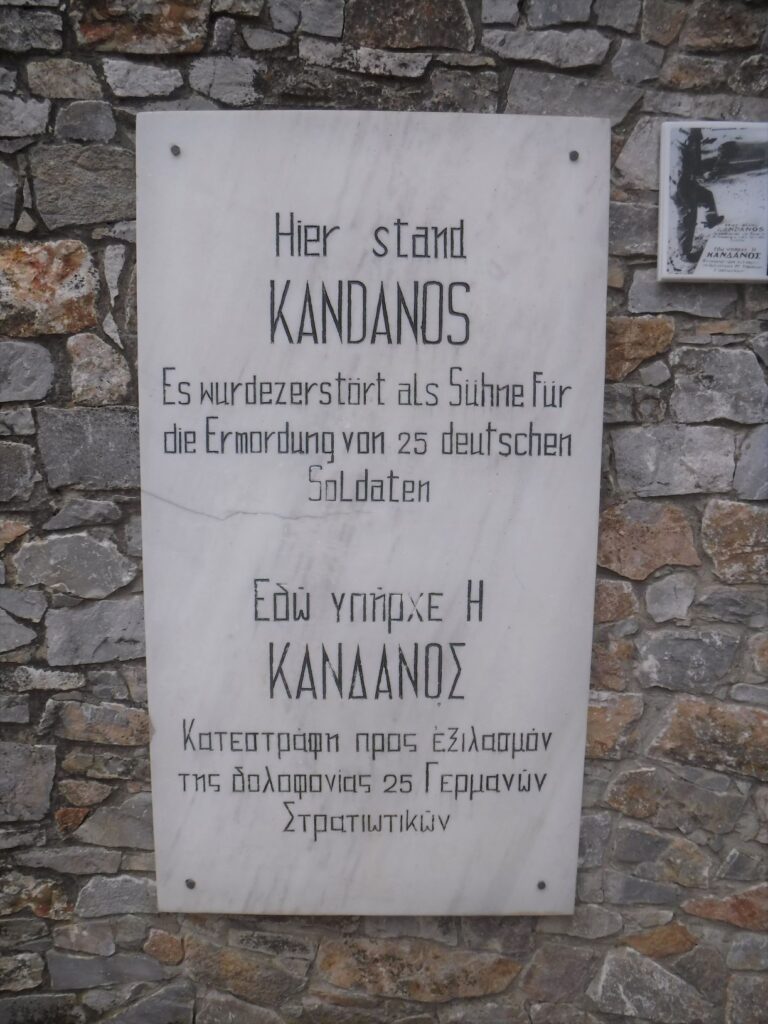

Left: ‘Here stood Kandanos, destroyed in retribution for the murder of 25 German soldiers‘ Right: ‘Kandanos was destroyed in retaliation for the bestial ambush murder of a paratrooper platoon and a half-platoon of military engineers by armed men and women‘ A third stone read: ‘For the bestial assassination of German paratroops…and because they resisted the Greater German Reich…Kandanos destroyed…never to be rebuilt‘
However Kandanos was indeed rebuilt, although the local people are determined not to let the tragic events of June 3rd 1941 be forgotten.
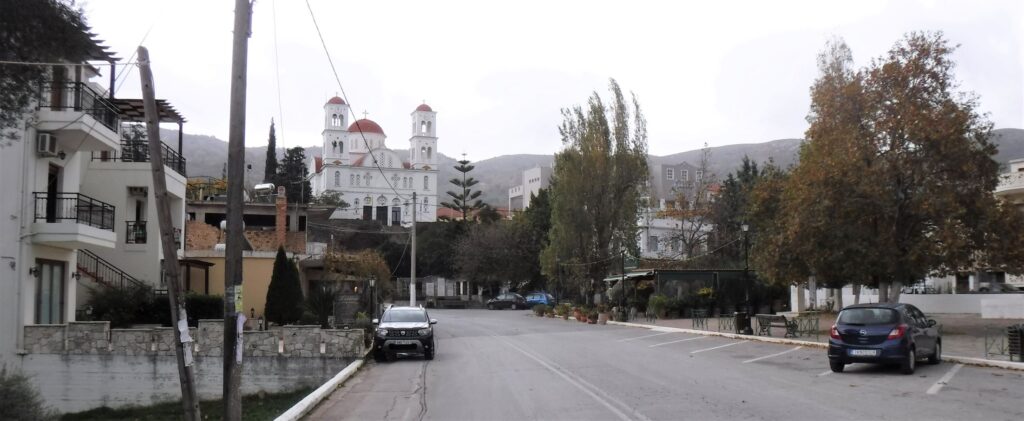
Just 10km north of Kandanos is the little village of Floria. Arriving in the town, I noticed a white marble monument, so pulled up in front of the neighbouring house to have a look. As I got out of the car, the door of the house opened, and an old lady peered out, perhaps wondering who had come to visit. I waved and smiled and pointed towards the monument. She smiled and disappeared back inside. The engraving on the monument was all in Greek, however the list of dates spanning 1941-4 explained its purpose. I found out later that Floria had suffered a similar fate to Kandanos.
I turned to walk back to the car, and an altogether different monument, partially obscured by vegetation, caught my eye. This memorial was erected in memory of German mountain troops killed in the Battle of Crete. Regardless of its provenance, preserving such a monument may be considered important so history is not forgotten. Alternatively, as stated in the German Military Cemetery museum in Maleme: ‘it is…debatable whether the mountain troop memorial in Floria, restored by private initiative, is an appropriate call to peace‘.5
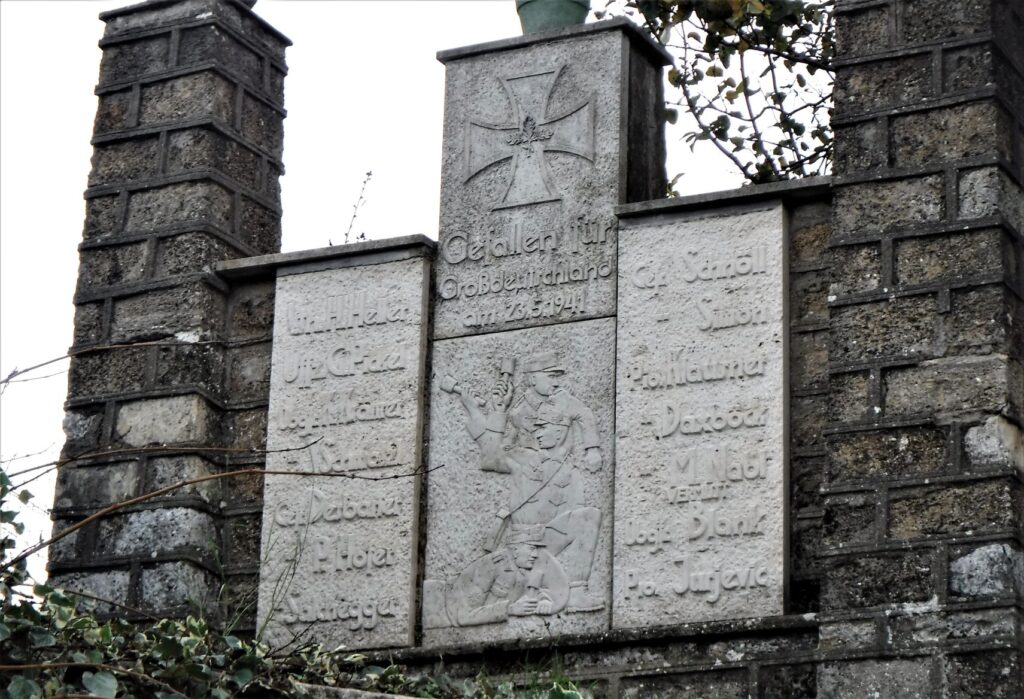
Whilst at the German Military Cemetery in Maleme, which contained a small museum, I saw photos of a German paratroopers’ memorial which had been built near Chania in 1943.
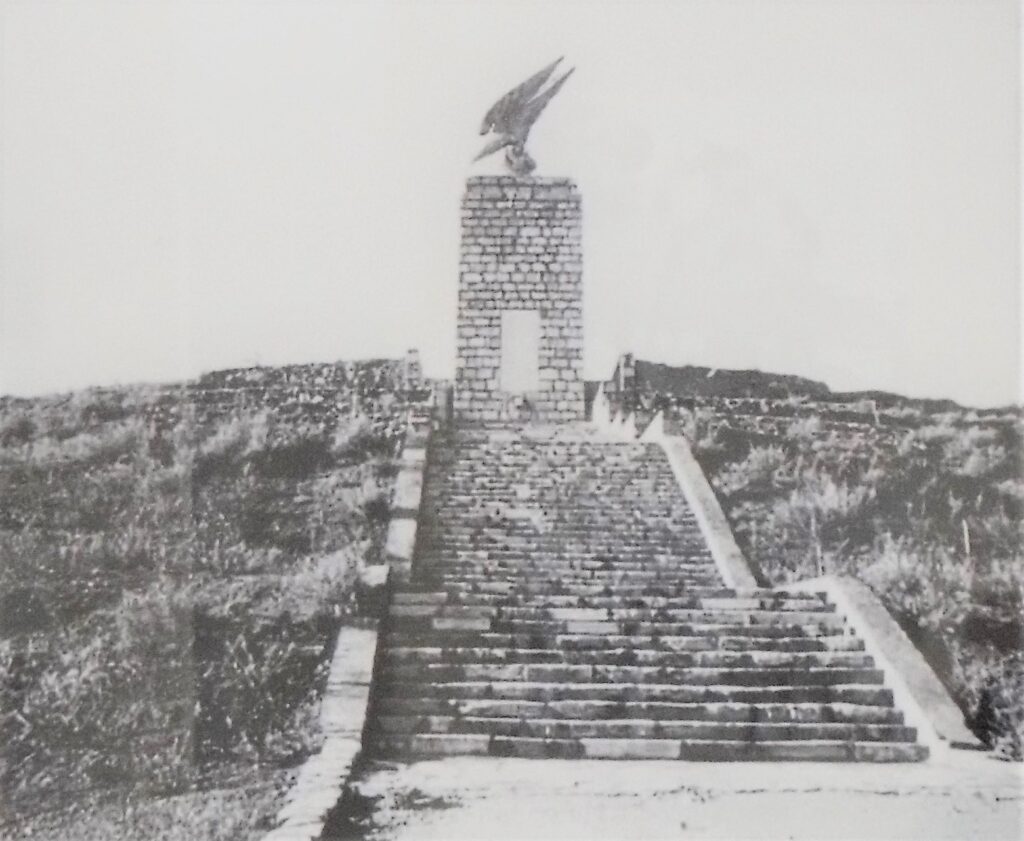
I can only imagine how galling the statue must have been for the Cretans under occupation: a conspicuous monument glorifying the ‘sacrifice’ made by the war dead of the invading force.
German paratroopers memorial, Chania
After a little research I discovered the memorial was still standing, so I set off for the western outskirts of Chania to see if I could find it.
Upon nearing my destination, I pulled off into a sidestreet and parked. I couldn’t immediately see the memorial, as the area had changed significantly in the 78 years since it was built. There was a repair shop on the sidestreet, and workers milling about, and I must admit I felt a little uncomfortable wandering around searching for the monument.
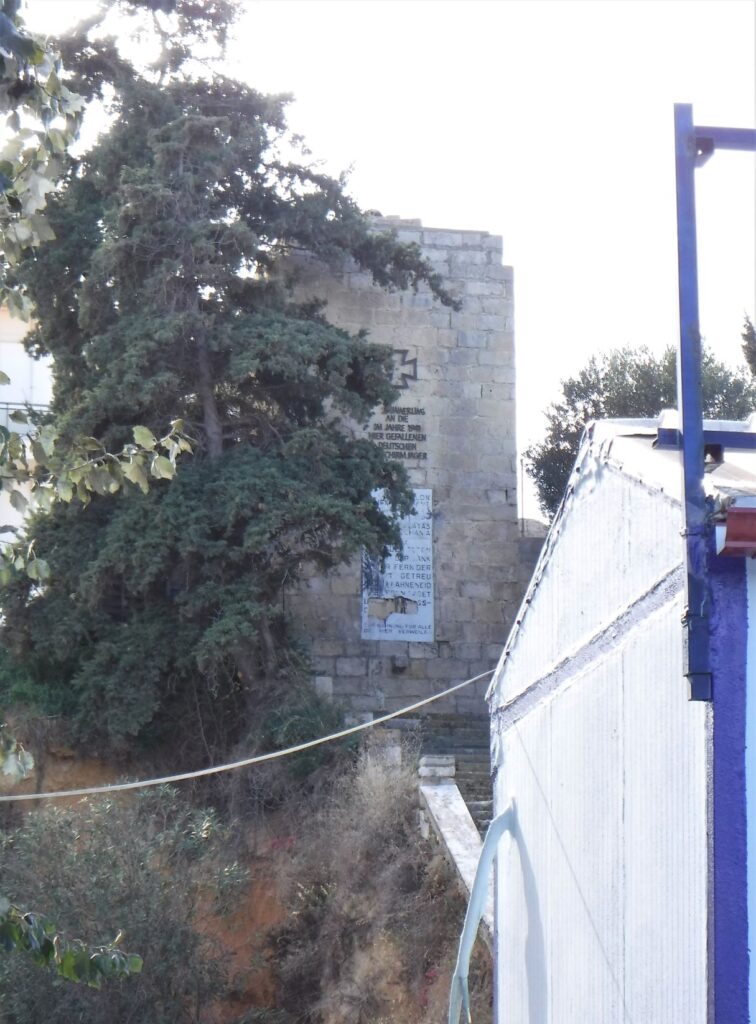
I wondered if they would ask me why I was there, and what sort of reaction I would get when I replied. The memorial was behind the workshop, partly obscured by trees, and I managed to take a quick photo without being noticed. The diving eagle had gone, but the white engraved panel could still be seen. The cross and black lettering appear to have been added after 1943.
German paratroopers memorial, Chania
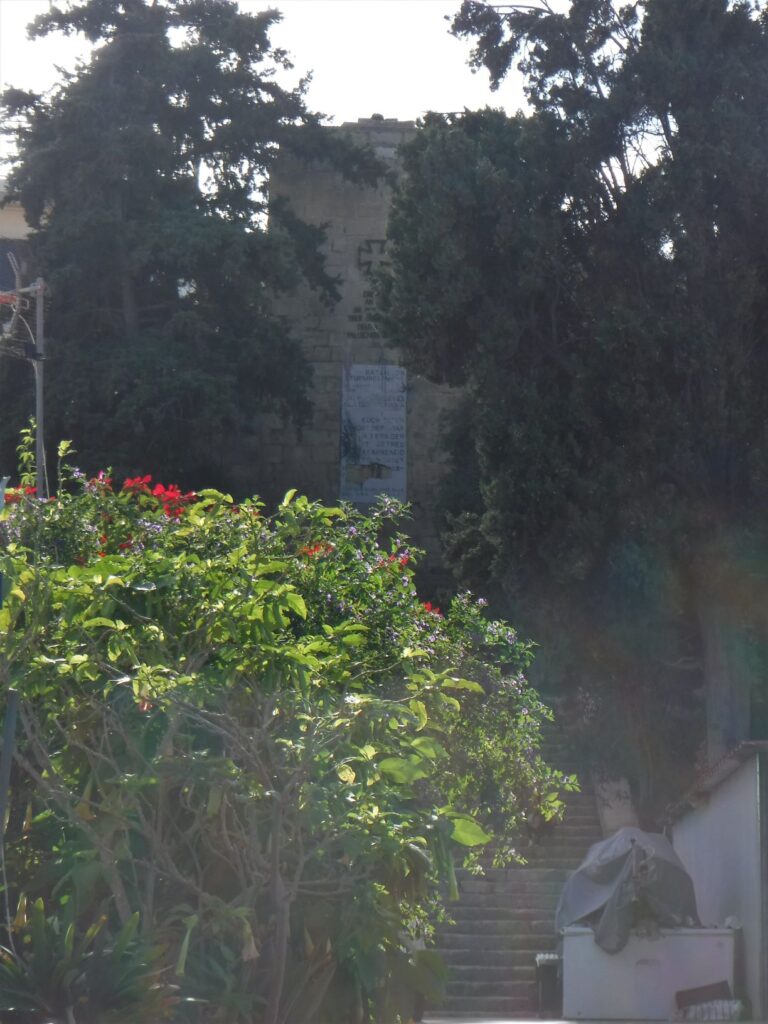
Walking around the front of the repair shop, I came to a block of flats that had been built in front of the monument. A dog starting barking, and a couple of people appeared out of the flats and started walking towards the road. I felt even more self-conscious, so took a badly light-affected photo and hurried back to my car.
The lower level of the stairs leading to the monument can be seen in the bottom-right of the photo.
German paratroopers memorial, Chania
My time on the island was drawing to an end, however there were still a few places of significance to the Battle of Crete that I wanted to visit before leaving.
To be continued…
1Bastion, R.J. (2007) ‘Hora Sphakia’, information panel, Hora Sfakia, Crete
2Carstairs, J. de M. (1941) ‘Escape from Crete’, Society of Cretan Historical Studies, Heraklion, 2016, p59
3Moss, W.S. (1950) ‘Ill Met by Moonlight’, Harrap, London, p113
4Chrysopoulos, P. (2021) ‘Crete remembers the razing of Kandanos by the Nazis on June 3,1941‘, Greek Reporter
5Information Panel, German Military Cemetery Museum, Maleme, Crete
If you enjoyed this post, you may also like: The Battle of Crete Part I, The Battle for Crete Part II
Do you have a particular interest in World War I, II and the Cold War? Check out my other blog Ghosts of War. If you enjoy military history, and want to know what it’s like to visit both significant and lesser-known wartime locations today, there’s something there for you.
Leave a Reply